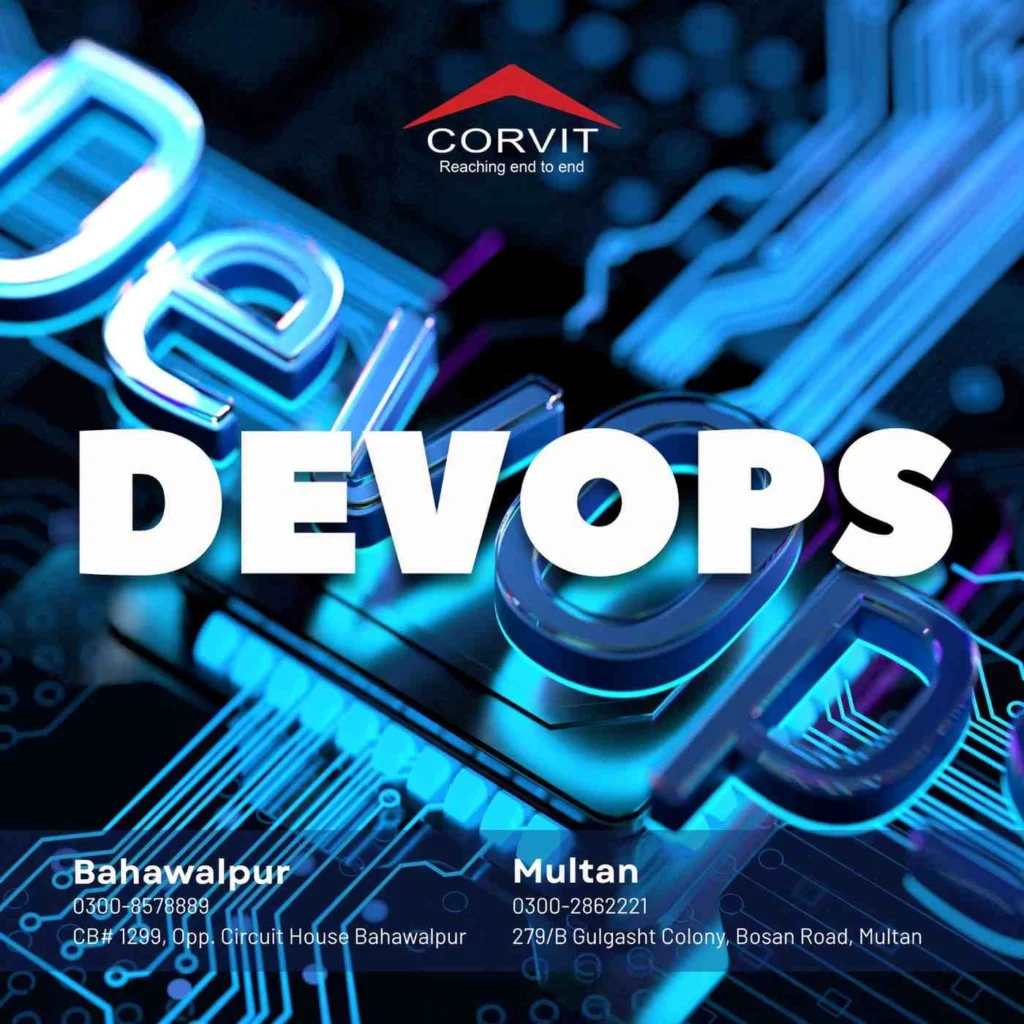Phone: +92 300 2862221 Email: corvitmultan@gmail.com


In the world of software development, there has always been a classic conflict: developers (Dev) want to release new features quickly, while the IT operations (Ops) team wants to ensure everything remains stable and reliable. This often creates a “wall of confusion” between the two teams, slowing down innovation and causing frustration.
What if there was a way to break down that wall? A way to build and release software faster, more reliably, and with better collaboration? That way is DevOps.
For IT students, developers, and system administrators in Multan, understanding DevOps is the key to unlocking the next level of your career. It’s about becoming a part of a modern, efficient culture that the world’s top tech companies rely on.
At its heart, DevOps is a culture of collaboration. It’s a philosophy where development and operations teams are merged into a single, unified team. Instead of working in separate silos, they work together throughout the entire software lifecycle, from development and testing to deployment and operations.
Think of it like this:
The Old Way (A Relay Race): The development team writes the code and “throws it over the wall” to the operations team to deploy and manage. If something breaks, they blame each other.
The DevOps Way (A Formula 1 Pit Crew): Everyone—developers, testers, and operations—works together in perfect sync. The goal is shared: make the car (the software) go as fast and as reliably as possible. Everyone is responsible for its success.
This culture is built on principles of automation, communication, and rapid feedback.
The core of putting the DevOps culture into practice is automation. The goal is to automate every step of the software delivery process to increase speed and reduce human error. This is achieved through something called a CI/CD Pipeline.
Continuous Integration (CI): Developers frequently merge their code changes into a central repository. Each time they do, an automated process kicks in to build the software and run tests to catch bugs early.
Continuous Delivery/Deployment (CD): Once the code passes all the tests, it is automatically prepared for release. In a Continuous Deployment model, it can even be pushed live to customers without any human intervention.
This pipeline allows companies to release new features and fixes to their users daily, or even hourly, instead of just once every few months.
While DevOps is a culture, it’s powered by a specific set of tools. In our course at Corvit Multan, you will get hands-on experience with the industry-standard toolkit:
Version Control: Git (to manage and track code changes).
Containerization: Docker (to package applications and their dependencies into portable containers).
Orchestration: Kubernetes (to manage and scale containerized applications automatically).
CI/CD Automation: Jenkins (to build, test, and deploy the CI/CD pipeline).
Cloud Platforms: AWS and Azure (the infrastructure where your applications will run).
As software houses and tech startups in Multan grow, they face intense competition. DevOps is no longer a luxury; it’s a necessity.
Speed to Market: Local companies need to build and release new features faster than their rivals.
Improved Stability: Businesses need their websites and apps to be highly reliable to keep customers happy.
Global Opportunities: The demand for DevOps engineers is so high globally that there are countless remote job opportunities for skilled professionals in Multan.
A career in DevOps puts you at the very heart of a modern tech company, making you one of its most valuable assets. You’ll be a problem-solver, an innovator, and a leader.
Our DevOps program is designed to transform you into a professional capable of building and managing modern software delivery pipelines.
Focus on Culture and Tools: We don’t just teach you tools; we teach you the DevOps mindset and how to apply it.
Build Your Own Pipeline: Our training is project-based. You will build a complete CI/CD pipeline from scratch, giving you an incredible project for your portfolio.
Learn In-Demand Technologies: Our curriculum is always updated to focus on the tools that companies are actually hiring for.
Expert Instructors: Learn from certified professionals who have implemented DevOps practices in real-world corporate environments.
DevOps is the future of how software is built and delivered. It’s a dynamic, challenging, and highly rewarding career path.
Ready to become an architect of modern software development? Enroll in our DevOps course at Corvit Systems Multan and start your journey!
Here are answers to some common questions we receive at our Multan institute.
The best DevOps professionals have a good understanding of both worlds. Our course is designed for people from either background (developers, system admins, network engineers) who want to bridge the gap and learn the full lifecycle.
It involves scripting for automation (e.g., using Python or Shell scripts), but it’s not the same as full-stack software development. The focus is on automating processes, not building application features from scratch.
Agile is a methodology for managing the development of software in short cycles. DevOps extends those Agile principles all the way through to deployment and operations. They work together perfectly.
No. DevOps has become the industry standard for high-performing tech organizations. It’s a fundamental shift in how technology teams work and is here to stay.



Copyright © 2025 – Corvit Systems Multan (Pvt) Ltd. All rights reserved.
